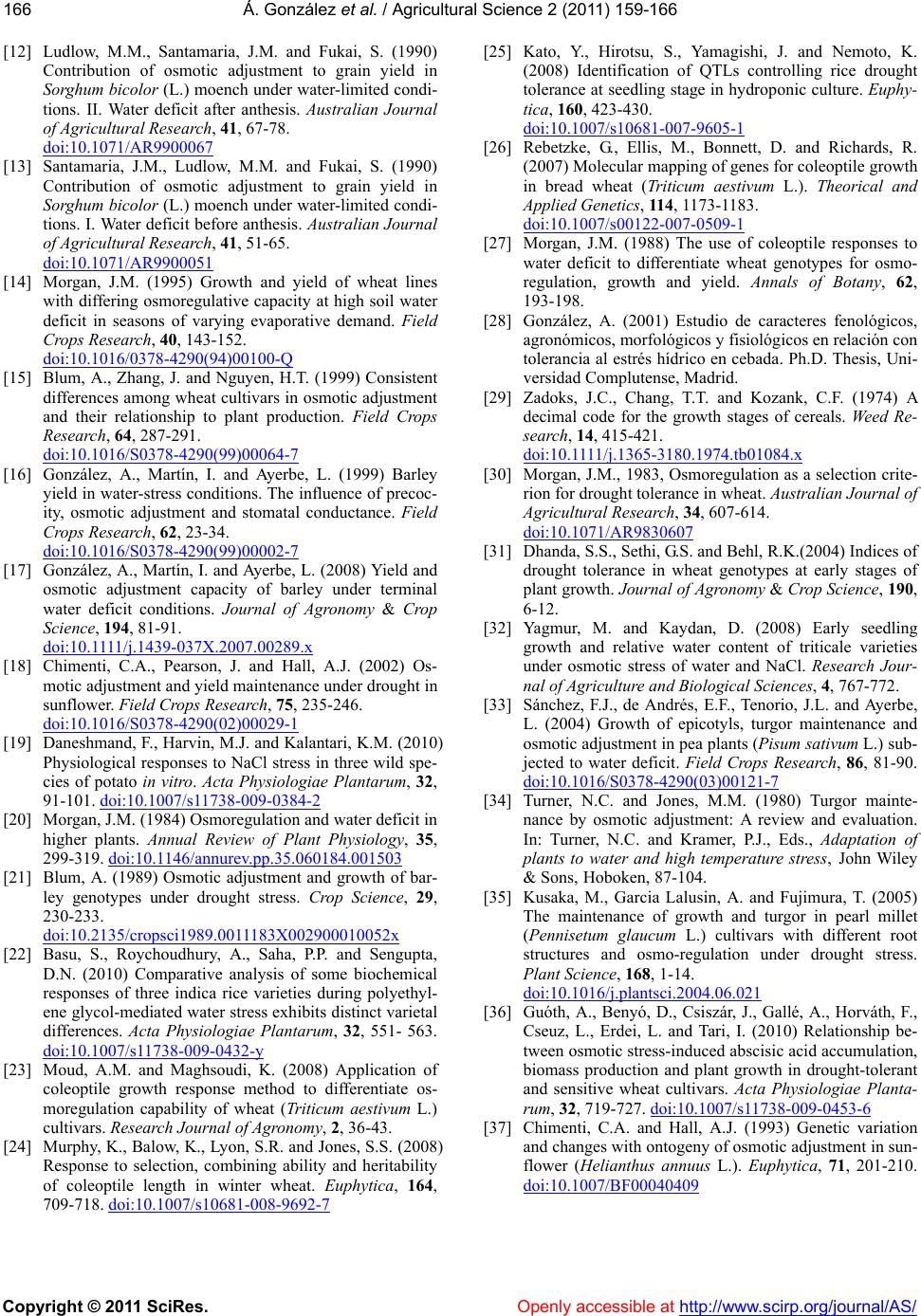
Á. González et al. / Agricultural Science 2 (2011) 159-166
Copyright © 2011 SciRes. http://www.scirp.org/journal/AS/Openly accessible at
166
[12] Ludlow, M.M., Santamaria, J.M. and Fukai, S. (1990)
Contribution of osmotic adjustment to grain yield in
Sorghum bicolor (L.) moench under water-limited condi-
tions. II. Water deficit after anthesis. Australian Journal
of Agricultural Research, 41, 67-78.
doi:10.1071/AR9900067
[13] Santamaria, J.M., Ludlow, M.M. and Fukai, S. (1990)
Contribution of osmotic adjustment to grain yield in
Sorghum bicolor (L.) moench under water-limited condi-
tions. I. Water deficit before anthesis. Australian Journal
of Agricultural Research, 41, 51-65.
doi:10.1071/AR9900051
[14] Morgan, J.M. (1995) Growth and yield of wheat lines
with differing osmoregulative capacity at high soil water
deficit in seasons of varying evaporative demand. Field
Crops Research, 40, 143-152.
doi:10.1016/0378-4290(94)00100-Q
[15] Blum, A., Zhang, J. and Nguyen, H.T. (1999) Consistent
differences among wheat cultivars in osmotic adjustment
and their relationship to plant production. Field Crops
Research, 64, 287-291.
doi:10.1016/S0378-4290(99)00064-7
[16] González, A., Martín, I. and Ayerbe, L. (1999) Barley
yield in water-stress conditions. The influence of precoc-
ity, osmotic adjustment and stomatal conductance. Field
Crops Research, 62, 23-34.
doi:10.1016/S0378-4290(99)00002-7
[17] González, A., Martín, I. and Ayerbe, L. (2008) Yield and
osmotic adjustment capacity of barley under terminal
water deficit conditions. Journal of Agronomy & Crop
Science, 194, 81-91.
doi:10.1111/j.1439-037X.2007.00289.x
[18] Chimenti, C.A., Pearson, J. and Hall, A.J. (2002) Os-
motic adjustment and yield maintenance under drought in
sunflower. Field Crops Research, 75, 235-246.
doi:10.1016/S0378-4290(02)00029-1
[19] Daneshmand, F., Harvin, M.J. and Kalantari, K.M. (2010)
Physiological responses to NaCl stress in three wild spe-
cies of potato in vitro. Acta Physiologiae Plantarum, 32,
91-101. doi:10.1007/s11738-009-0384-2
[20] Morgan, J.M. (1984) Osmoregulation and water deficit in
higher plants. Annual Review of Plant Physiology, 35,
299-319. doi:10.1146/annurev.pp.35.060184.001503
[21] Blum, A. (1989) Osmotic adjustment and growth of bar-
ley genotypes under drought stress. Crop Science, 29,
230-233.
doi:10.2135/cropsci1989.0011183X002900010052x
[22] Basu, S., Roychoudhury, A., Saha, P.P. and Sengupta,
D.N. (2010) Comparative analysis of some biochemical
responses of three indica rice varieties during polyethyl-
ene glycol-mediated water stress exhibits distinct varietal
differences. Acta Physiologiae Plantarum, 32, 551- 563.
doi:10.1007/s11738-009-0432-y
[23] Moud, A.M. and Maghsoudi, K. (2008) Application of
coleoptile growth response method to differentiate os-
moregulation capability of wheat (Triticum aestivum L.)
cultivars. Research Journal of Agronomy, 2, 36-43.
[24] Murphy, K., Balow, K., Lyon, S.R. and Jones, S.S. (2008)
Response to selection, combining ability and heritability
of coleoptile length in winter wheat. Euphytica, 164,
709-718. doi:10.1007/s10681-008-9692-7
[25] Kato, Y., Hirotsu, S., Yamagishi, J. and Nemoto, K.
(2008) Identification of QTLs controlling rice drought
tolerance at seedling stage in hydroponic culture. Euphy-
tica, 160, 423-430.
doi:10.1007/s10681-007-9605-1
[26] Rebetzke, G., Ellis, M., Bonnett, D. and Richards, R.
(2007) Molecular mapping of genes for coleoptile growth
in bread wheat (Triticum aestivum L.). Theorical and
Applied Genetics, 11 4, 1173-1183.
doi:10.1007/s00122-007-0509-1
[27] Morgan, J.M. (1988) The use of coleoptile responses to
water deficit to differentiate wheat genotypes for osmo-
regulation, growth and yield. Annals of Botany, 62,
193-198.
[28] González, A. (2001) Estudio de caracteres fenológicos,
agronómicos, morfológicos y fisiológicos en relación con
tolerancia al estrés hídrico en cebada. Ph.D. Thesis, Uni-
versidad Complutense, Madrid.
[29] Zadoks, J.C., Chang, T.T. and Kozank, C.F. (1974) A
decimal code for the growth stages of cereals. Weed Re-
search, 14, 415-421.
doi:10.1111/j.1365-3180.1974.tb01084.x
[30] Morgan, J.M., 1983, Osmoregulation as a selection crite-
rion for drought tolerance in wheat. Australian Journal of
Agricultural Research, 34, 607-614.
doi:10.1071/AR9830607
[31] Dhanda, S.S., Sethi, G.S. and Behl, R.K.(2004) Indices of
drought tolerance in wheat genotypes at early stages of
plant growth. Journal of Agronomy & Crop Science, 190,
6-12.
[32] Yagmur, M. and Kaydan, D. (2008) Early seedling
growth and relative water content of triticale varieties
under osmotic stress of water and NaCl. Research Jour-
nal of Agriculture and Biological Sciences, 4, 767-772.
[33] Sánchez, F.J., de Andrés, E.F., Tenorio, J.L. and Ayerbe,
L. (2004) Growth of epicotyls, turgor maintenance and
osmotic adjustment in pea plants (Pisum sativum L.) sub-
jected to water deficit. Field Crops Research, 86, 81-90.
doi:10.1016/S0378-4290(03)00121-7
[34] Turner, N.C. and Jones, M.M. (1980) Turgor mainte-
nance by osmotic adjustment: A review and evaluation.
In: Turner, N.C. and Kramer, P.J., Eds., Adaptation of
plants to water and high temperature stress, John Wiley
& Sons, Hoboken, 87-104.
[35] Kusaka, M., Garcia Lalusin, A. and Fujimura, T. (2005)
The maintenance of growth and turgor in pearl millet
(Pennisetum glaucum L.) cultivars with different root
structures and osmo-regulation under drought stress.
Plant Science, 168, 1-14.
doi:10.1016/j.plantsci.2004.06.021
[36] Guóth, A., Benyó, D., Csiszár, J., Gallé, A., Horváth, F.,
Cseuz, L., Erdei, L. and Tari, I. (2010) Relationship be-
tween osmotic stress-induced abscisic acid accumulation,
biomass production and plant growth in drought-tolerant
and sensitive wheat cultivars. Acta Physiologiae Planta-
rum, 32, 719-727. doi:10.1007/s11738-009-0453-6
[37] Chimenti, C.A. and Hall, A.J. (1993) Genetic variation
and changes with ontogeny of osmotic adjustment in sun-
flower (Helianthus annuus L.). Euphytica, 71, 201-210.
doi:10.1007/BF00040409